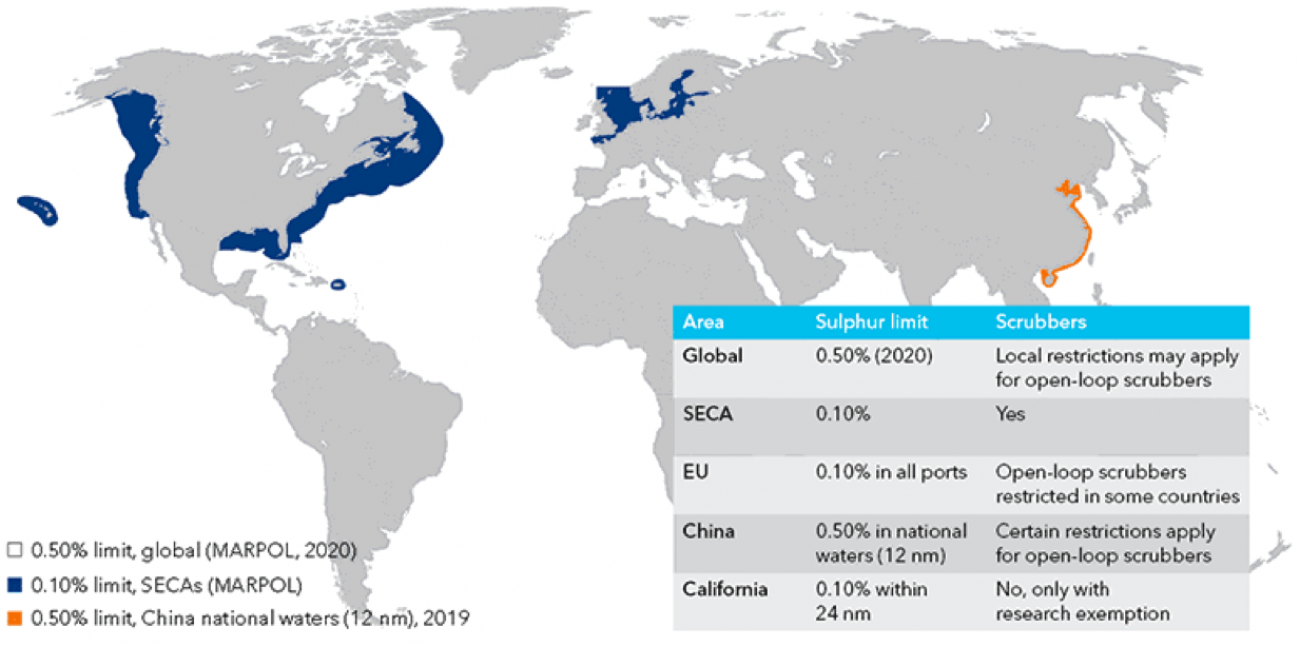As fuels with different sulphur content are in use on board ships, compliance with the limit of the ECAs can be a challenge for the crew. Beside the global 0.50% sulphur cap – entering into force in 2020, and already in force in Chinese waters – emissions control in several ECAs with a 0.10% sulphur limit are already in place.
DNV, MARCH 2019

The PSC performs regular inspections on board ships, with a focus on sulphur limits, and a significant increase of sulphur related deficiencies has been noticed by PSC within the last years. Some authorities will monitor the exhaust gas plume as a first indication to trigger the PSC inspection of a ship. DNV GL is working closely with owners and operators to stay compliant. Here are a few recommendations:
Typical deficiencies noticed by PSC
Typical deficiencies include missing bunker delivery notes, wrong tank sounding records, incorrect log book entries or a not correctly followed fuel-changeover procedure. In specific cases, such findings can be considered objective evidence of a serious ISM failure, requiring a safety management audit. To avoid such deficiencies, the crew on board should be aware of the problem and trained accordingly.
Bunker delivery notes
- To be kept on board for three years
- To be stored readily available for inspection
Quality of fuel
The fuel quality is also subject for inspection:
- Delivery of fuel to be accompanied by representative fuel samples
- Fuel samples are to be sealed and signed by supplier and crew representative
- To be kept on board for 12 months from delivery
A fuel changeover (FCO) procedure must be in place
- Fuel oil service system to be fully flushed through, enabling the crew to calculate the starting time
- Crew to be trained to handle challenges and manage risks:
- Incompatibility of fuel oils / filter problems
- Low viscosity of distillate fuel / fuel pump failure and injection valve problems
- To be carried out slowly in accordance with manufacturer’s instruction (2°C/minute) / thermal shock of injection equipment
- Volume of low-sulphur fuel onboard, date, time and position when the FCO procedure was completed prior to entering an ECA shall be recorded. The same to be recorded when commencing the FCO after leaving the ECA.
As all operators know, high-sulphur HFO is less expensive than the MGO containing 0.10% sulphur by mass, which is a motivation for the preferred use of HFO. To ensure that the sulphur content meets the ECA limit, the fuel changeover procedure needs to be initiated well in advance considering consumption, volume of the service system, and the different sulphur levels used or mixed up already in tanks. Various fuel changeover tools exist, including the DNV GL FCO calculator which provides ship-specific solutions.
Recommendations
Port state authorities regularly inspect ships for ECA compliance, and we recommend paying attention to the following:
- Raise the awareness for fuel switching when entering ECAs.
- Train the crew in handling and documenting fuel oil matters (e.g. bunker delivery notes, changeover procedure, log book entries and tank sounding records).
- Start the fuel changeover procedure well in advance (depending on consumption, volume of service system and different sulphur levels used or mixed in tanks).
References
- MARPOL Annex VI, Reg. 14.4 [Sulphur Oxides (SOx) and Particulate Matter];
- MARPOL Annex VI, Reg.18 [Fuel oil availability and quality]
- Directive (EU) 2016/802 relating to a reduction in the Sulphur content of certain liquid fuels
DNV GL resources:
- Fuel-change-over calculator web page
- Global sulphur cap 2020 web page